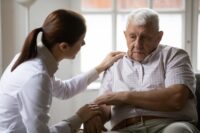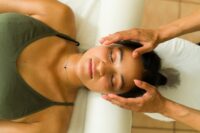Falls, typical incidents among older adults in the nursing home, are associated with debility, functional impairment, and mortality. Falls resulting in injury and medical complication have proven to be costly, and once the elderly fall, they develop a fear of falling again. This fear reduces movement adding the risk of developing a co-morbid condition such as pressure injury, pneumonia, and depression related to feelings of isolation. Falls thus affect the quality of life among older adults.
State regulation on elderly care mandates institutions to incorporate fall intervention programs into their policies. Nurses have an active role in assessing the risk of falls and implementing an evidence-based intervention to prevent and minimize the impact of falls among vulnerable individuals. Understanding current knowledge about falls in the elderly and evidence-based fall intervention and strategies can help nurses keep patients safe.
Falls in older adults
Falls are associated with multiple risk factors, including biological, behavioral, and environmental.
- Biological factors can be older age, chronic diseases, low vitamin D level, urinary incontinence, gait and balance disorder, orthostatic hypotension, chronic pain, and altered sensory perceptions.
- Behavioral factors include lack of exercise, fear of falling, feelings of anxiety, symptoms of depression, low self-efficacy, history of falls, behavioral disruption associated with dementia, tremors, and impaired cognitive abilities.
- Environmental factors include inappropriate footwear, hazardous objects like loose wires, slippery floors, poor lighting, and improper use of assistive devices.
Other factors are side effects from medications such as orthostatic hypotension, increased drowsiness, and lethargy.
Strategies to prevent falls
Multiple interventions can be used to reduce modifiable risk factors and prevent impact and injury associated with fall. Examples are
- balance, gait and strength training
- individualized or group physical therapy
- Tai Chi
- environmental modifications
- home safety awareness
- correcting vitamin D deficiency
- minimizing the number of medications
- decreasing use of psychotropic, anti-anxiety, anti-depressants, and sedatives
- treating vision and hearing impairments
- correcting arrhythmia
- managing foot and footwear issues.
El-Khoury and colleagues conducted a meta-analysis of randomized controlled trials to investigate that showed exercise consisting of gait, balance and functional training, strengthening exercises, and flexibility is the most effective intervention.
Three approaches have been developed to address falls—single, multifactorial, and multi-component approach.
A single approach identifies the cause and effect anduses one interventionat a time to manage falls. For example, balance and gait deviation is prescribed with a physical therapy program. Postural hypotension is controlled by altering the dose of medications. This method is considered inferior because it does not see the multidimensionality of falls.
The multifactorial approach recognizes that several factors contribute to why the elderly are at risk for falls, so the prescription is highly varied and individualized to the patient. Individuals are provided with two or more interventions based on the target risk factors associated with the risk of falls. For example, based on risk factors, one person might be prescribed exercise and environmental modification, while another person receives exercise and managing foot and footwear problems.
In the multi-component approach, the older adult receives a two or more fixed prescribed regimen for falls. For example, exercise + vitamin D supplementation, managing arrhythmia + managing postural hypotension + medications, treating vision and hearing impairment + performing the environmental modification are strategies to a multi-component approach. The multi-component is a grouped approach to a common risk identified.
Stubbs and colleagues conducted a systematic review and meta-analysis of 17 randomized controlled trials related to falls interventions, totaling about 5,000 participants. The analysis showed that multiple component interventions areeffective in preventing falls and injury associated with older people as compared to single and multifactorial approach. It’s safe to conclude that including exercise as part of the routine care to prevent fall and using multi-component interventions are the best practices identified in the literature.
Protecting patients
Nurses have the responsibility to integrate, communicate, and coordinate evidence-based strategies to reduce the risk of falls in older adults. Nurses can also play a positive role in minimizing the impact of injury should a fall occur.
Amil Tan is nurse manager at the Riverside Premier Rehabilitation and Healing Center in New York.
Selected references
Center for Disease Control and Prevention. Important facts about falls. 2017.cdc.gov/homeandrecreationalsafety/falls/adultfalls.html
El-Khoury F, Cassou B, Charles M, Dargent-Molina P. The effect of fall prevention exercise programs on fall induced injuries in community-dwelling older adults: systematic review and meta-analysis of randomized controlled trials. Br Med J. 2013;347(16234):1-13.
Goodwin VA, Abbott RA, Whear R, Bethel A, Ukoumunne OC, Thompson-Coon J, Stein K. Multiple component interventions for preventing falls and fall-related injuries among older people: systematic review and meta-analysis. BMC Geriatrics. 2014;14(1):15.
Johnell K, Jonasdottir Bergman G, Fastbom J, Danielsson B, Borg N, Salmi P. Psychotropic drugs and the risk of fall injuries, hospitalizations and mortality among older adults. Int J Geriatr Psychiatry. 2017;32(4):414-420.
Kempen GI, van Haastregt JC, McKee KJ, Delbaere K, Zijlstra GA. Sociodemographic, health-related and psychological correlates of fear of falling and avoidance of activity in community-living older persons who avoid activity due to fear of falling. BMC Public Health. 2009;9,170.
Patton S. Using an online learning module in a nursing program to improve knowledge and skills to prevent falls in the community-dwelling older adult population: Doctoral dissertation. Proquest LLC. Michigan, USA. 2016. scholarworks.uark.edu/cgi/viewcontent.cgi?article=2454&context=etd
Stubbs B, Brefka S, Denkinger MD. What works to prevent falls in community-dwelling older adults? Umbrella review of meta-analyses of randomized controlled trials.Phys Ther.2015; 95(8):1095-1110.


















